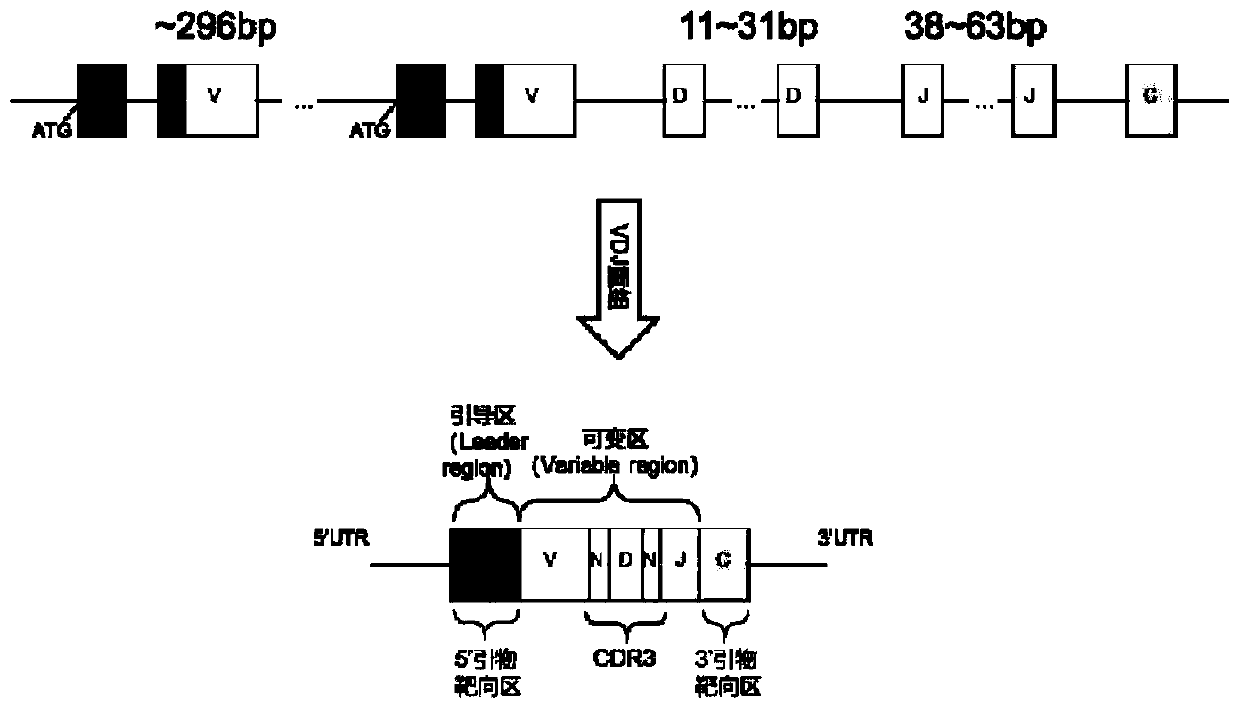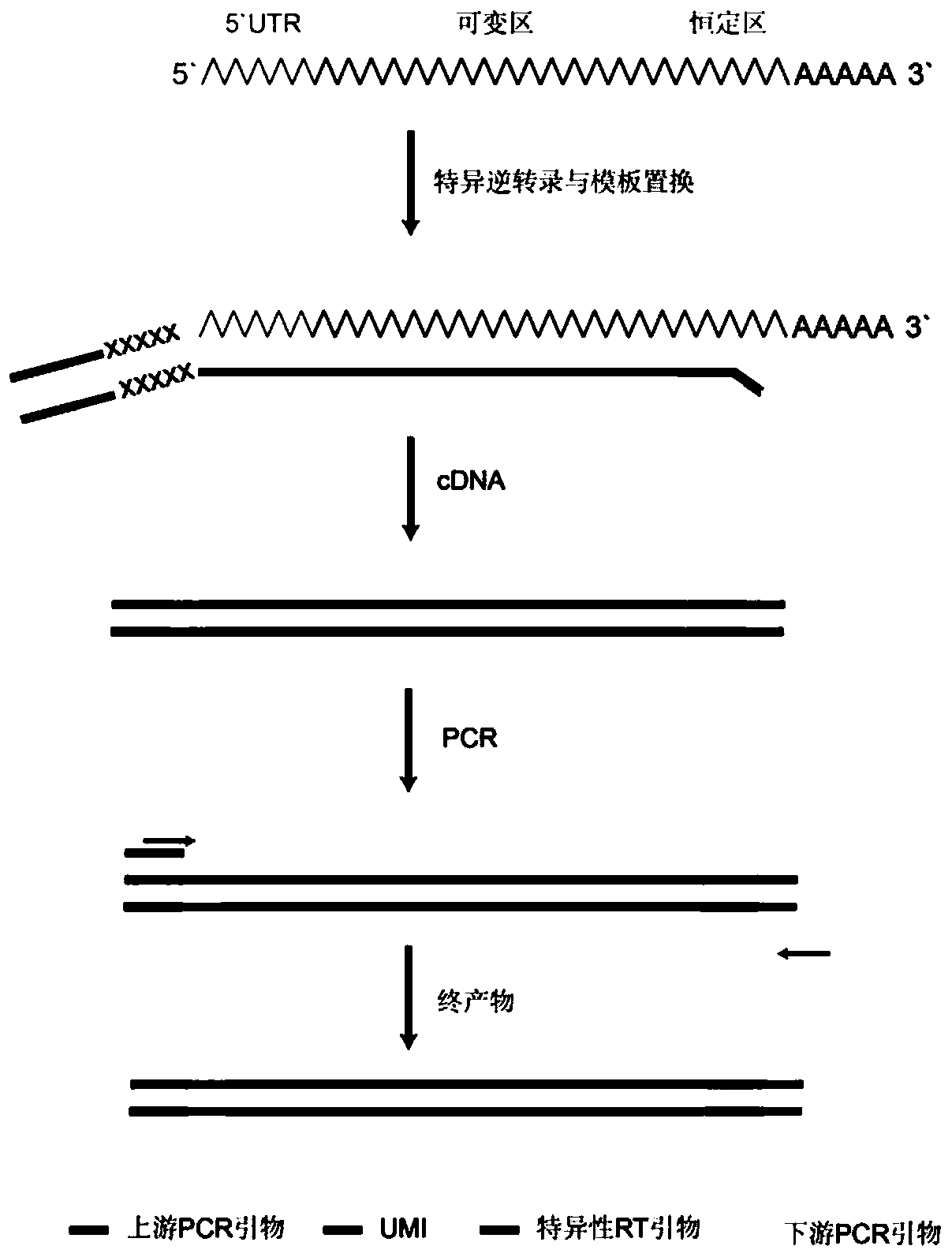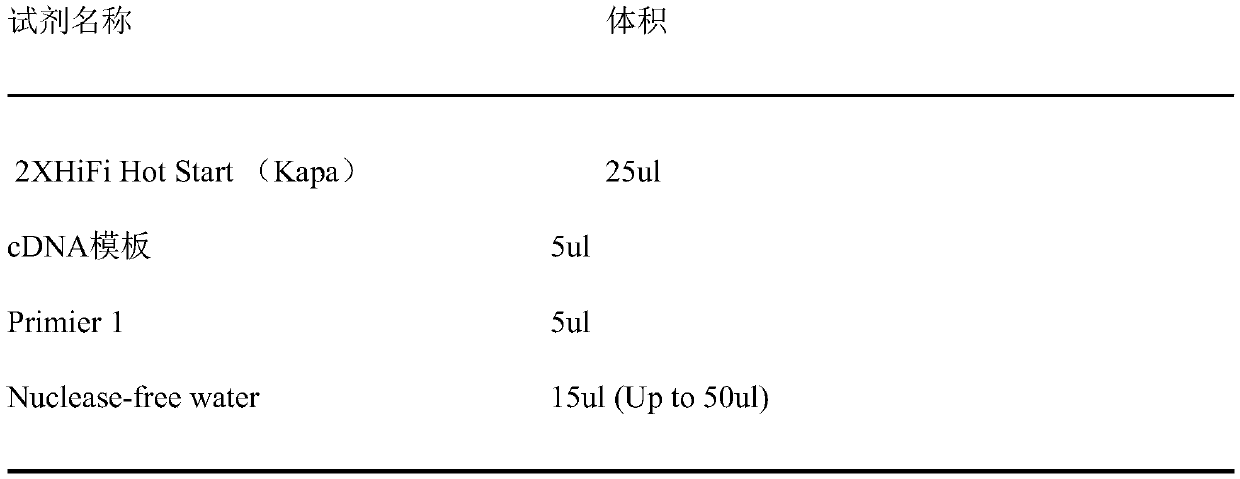Immunological group library method for discriminating self-cross-reaction of independent sample
A technology of cross-reaction and immune group library, applied in chemical library, combinatorial chemistry, library creation, etc., can solve the problems of incomplete capture of alleles, multi-primer reaction can not achieve equivalent amplification, no relief, etc.
- Summary
- Abstract
- Description
- Claims
- Application Information
AI Technical Summary
Problems solved by technology
Method used
Image
Examples
Embodiment 1
[0093] Example 1 1ml Human Peripheral Blood Sample Immune Repertoire High-throughput Sequencing Library Construction Method
[0094] 1. Preparation of cDNA template
[0095] (1) Collect 1ml of human peripheral blood with EDTA anticoagulant tube, separate mononuclear cells in the blood by density gradient centrifugation, add 600ul cell lysate for cell lysis, and use RNA extraction kit for RNA extraction. (2) Detect the integrity of RNA and measure the concentration of RNA. (3) Configure the mixed system according to the following Table 9, and carry out the reaction on the PCR instrument. The reaction program is: 70°C, 1 min. After the reaction program is completed, immediately put the product on ice for 3 min. Table 9
[0096]
[0097]
[0098] (4) Configure the mixing system in Table 10 below, mix it with the product of step (3) and put it on the PCR instrument for reaction. The reaction program is: 42°C, 90min, 75°C, 15min, 4°C, ∞. The product after the reaction is t...
Embodiment 2
[0127] Example 2: Construction of high-throughput sequencing library of immune repertoire of 1mg human breast cancer tissue sample
[0128] 1. Preparation of cDNA template
[0129] (1) Take out human breast cancer tissue samples from liquid nitrogen or -80°C refrigerator, weigh 1 mg, grind the tissue into powder by liquid nitrogen grinding method, add 600ul cell lysate for cell lysis, use RNA extraction kit for RNA extraction. (2) Detect the integrity of RNA and measure the concentration of RNA. (3) Configure the mixed system according to the following Table 18, and carry out the reaction on the PCR instrument. The reaction program is: 70°C, 1 min. After the reaction program is completed, immediately put the product on ice for 3 min.
[0130] Table 18
[0131]
[0132]
[0133] (4) Configure the mixing system in Table 19 below, mix it with the product of step (3) and put it on the PCR instrument for reaction. The reaction program is: 42°C, 90min, 75°C, 15min, 4°C, ∞. ...
Embodiment 3
[0163] By comparing the number of UMI types in the sample sequence, after correcting the UMI sequence itself, the sequence is screened according to the correction of the double-ended UMI to improve the accuracy of the sample sequence and reduce the bias caused by PCR errors and sequencing errors. The data of the 14 libraries used in the test are shown in Table 29 and figure 2 shown. Table 29:
[0164]
[0165]
[0166] surface figure 2 :
[0167]
[0168] Through Table 29 and Table figure 2 It can be seen from the results that the distribution of the double-ended UMI sequences added in the sample by the present invention is relatively uniform, and the technology is feasible. Through the application of double-ended UMI, most of the UMI types have been corrected. Through the corrected double-ended UMI sequence and a considerable number of combinations with the number of the same UMI sequence greater than 2, we can perform more accurate analysis of the sample sequ...
PUM
 Login to View More
Login to View More Abstract
Description
Claims
Application Information
 Login to View More
Login to View More - R&D
- Intellectual Property
- Life Sciences
- Materials
- Tech Scout
- Unparalleled Data Quality
- Higher Quality Content
- 60% Fewer Hallucinations
Browse by: Latest US Patents, China's latest patents, Technical Efficacy Thesaurus, Application Domain, Technology Topic, Popular Technical Reports.
© 2025 PatSnap. All rights reserved.Legal|Privacy policy|Modern Slavery Act Transparency Statement|Sitemap|About US| Contact US: help@patsnap.com



